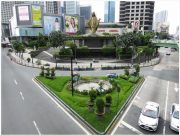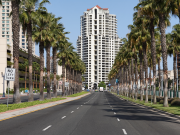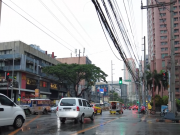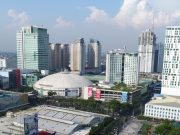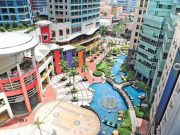As urbanization rapidly grows, it’s no surprise that new developments are constantly rising in various areas. Let us look at some up-and-coming areas in Metro Manila that are becoming popular for property investment opportunities.

Metro Manila Neighborhoods
Metro Manila, with a population of 12.8 million, is renowned for its bustling cities like Makati, Taguig, and Quezon City. It is home to diverse ethnic groups, including Tagalogs, Bicolanos, Visayans, and Ilocanos. The region also sees a notable presence of foreign nationals, including Chinese, Americans, and Koreans. Despite challenges, the region has witnessed rapid growth throughout its history, covering an area of more than 600 square kilometers in the southwestern portion of Luzon; this metropolis is one of the most densely populated cities in the world.
Metro Manila: A Compass Rose
The North: A Mix of Old and New
In contrast to the bustling and vibrant South and the emerging and rapidly evolving East, the North offers a captivating blend of old-world charm and exciting new developments. Influenced by a fascinating history, Quezon City, Caloocan, and Valenzuela are rich in architecture tracing back to Spanish colonial eras.
These cities proudly display a lasting legacy and cultural heritage that has withstood the test of time. From quaint colonial architecture to vibrant local communities, the North invites exploration and promises a unique experience that seamlessly weaves together tradition and progress.
The South: A Surging Market
In recent years, the southern part of Metro Manila has seen a surge in property development and investment opportunities. Cities such as Parañaque, Muntinlupa, and Las Piñas have become prime locations for residential properties, with numerous condominium projects and gated communities.
One major factor contributing to the growth of the south is its proximity to other business districts such as Parañaque, Las Piñas, and Muntinlupa. With gridlock in Metro Manila, living in the south offers a more convenient commute for those working in these areas. Additionally, the south offers a more relaxed suburban lifestyle against the busy and fast-paced city center.
The East: An Emerging Hub
While the South has been gaining traction, the East is also emerging as an investment hotspot. Cities like Pasig and Marikina are experiencing rapid development, with new residential projects and commercial establishments.
One of the highlights in the east is the Ortigas Center, a business district home to many multinational corporations and commercial establishments. It also boasts a thriving food and entertainment scene, making it an attractive location for young professionals and families.
Aside from the Ortigas Center, other areas in the east, Antipolo, Cainta, and Taytay in Rizal Province, are also seeing growth in their residential and commercial sectors. These cities offer more affordable living options than the neighboring central business districts, making them popular choices for those looking for a balanced work and personal life.
The West: A Growing Suburb
Another up-and-coming area in Metro Manila is the West. While Malabon and San Juan City may not be as bustling as Manila, they offer more affordable options for property investments. These districts are also home to many universities and schools, making it an ideal location for rental properties.
Aside from Quezon City, the neighboring provinces of Bulacan and Pampanga are also experiencing rapid growth in real estate development. These areas provide a quieter and suburban lifestyle while remaining accessible to Metro Manila through major highways.
The Rise of Mixed-Use Developments
One of the biggest trends in Metro Manila’s real estate market is the rise of mixed-use developments. These are combined residential, commercial, and leisure components into one integrated space that are developments for the convenience of residents and also create a sense of community that provides a well-rounded lifestyle within one location.
One notable mixed-use development in Metro Manila is Fort Bonifacio Global City (Fort BGC) in Taguig City. This former military base has transformed into an energetic business district with high-end residential condominiums, shopping centers, restaurants, and recreational spaces. Fort BGC has become a choice for local and foreign investors due to its strategic location, modern infrastructure, and vibrant community.
Economic Landscape
The National Capital Region (NCR) plays a vital role in the nation’s economic, political, and cultural fabric, encompassing 16 cities and one municipality. Boasting a sizable population, Metro Manila posted a 7.18 positive growth rate in Gross Regional Domestic Expenditures (GRDE) in 2022, fueled by a wide range of business and financial undertakings.
Many multinational companies have established their headquarters or regional offices in Metro Manila, attracting local and foreign investments. This region boasts a vibrant economy that fuels diverse employment opportunities, contributing significantly to the overall economic growth.
Infrastructure and Transportation Development
Metro Manila has an extensive transportation network to cater to its growing population and economic activities. The region has various modes of transportation, such as buses, jeepneys, trains, and taxis. In a continuous effort to tackle traffic congestion and offer efficient transportation services to residents and visitors, the region is consistently enhancing its infrastructure. New expressways and railway systems are on the way to improve connectivity and make commuting within the metropolitan area easier.
Exciting Prospects for Property Investment
A. Residential Real Estate
1. Condominiums
Due to the growing preference for urban living, condominiums have gained popularity among young professionals and families. These contemporary developments offer modern amenities, sustainable design, and smart home technology.
Thriving Real Estate Landscape in 2024: New Supply, Prices Set to Rise
Colliers anticipates a dynamic and prosperous outlook for the real estate market in 2024, following insights from the performance in 2023.
Record-breaking Pre-selling Condominium Sales in 2023:
In 2023, the real estate sector reached a significant milestone by selling approximately 3,400 pre-selling condominium units. This achievement showcases the industry’s growth and success in meeting the demands of buyers. Anticipated easing in interest and mortgage rates in 2024 will fuel the demand for residential units, positioning the year ahead as promising for the real estate market.
Construction Challenges and New Supply Dominance in 2024:
The delivery of 3,540 units in 2023, slightly below the initial estimate of 4,920 units due to construction delays. However, with the hope of the Bay Area taking the lead in new supply in 2024, showcasing a resilient real estate market that adapts and thrives despite challenges.
Rent to Increase and Promising Recovery:
Rental rates in Philippine Pesos (PHP/sqm) for studio and one-bedroom units in central business districts have changed from Q1 2020 vs Q4 2023. In Makati CBD, the average rate decreased by 22% to 1,100 PHP/sqm. Fort Bonifacio Global City saw a slight drop of 6% to 940 PHP/sqm, while Ortigas Center decreased by 14% to 910 PHP/sqm. These changes reflect shifting demand and market conditions.
Overall residential rents rose by 3.5% in 2023, driven by robust leasing activity from local employees and the anticipated return of expatriates. In 2024, vacancy rates are predicted to increase, especially in the Bay Area, with the Central Business District (CBD) accounting for 63% of new supply.
Price Surge Anticipated in 2024:
An estimated price growth of 2.1% in 2024, underpinned by a stable take-up of mid-income units in key business hubs, this positive outlook reflects the market’s resilience and the sustained demand for quality residential spaces.
Optimism about 2024:
Optimism remains about the real estate landscape in 2024. Despite challenges faced in construction and the potential increase in vacancy rates, the market’s adaptability and the promising demand for residential units set the stage for a thriving year.
2. Townhouses
Townhouses provide a perfect balance of privacy and community living. Recent developments prioritize modern and spacious townhouses with eco-friendly features and convenient access to amenities.
3. Suburban Developments
Suburban areas are experiencing a surge in popularity, with new developments catering to families seeking a quieter and more spacious living environment. Recent developments have emphasized green spaces, family-friendly amenities, and convenient access to schools and shopping centers.
B. Commercial Real Estate
1. Office Spaces
Office spaces evolve based on the changing needs of businesses. Modern offices focus on flexible and collaborative workspaces, advanced technology infrastructure, and sustainability.
Optimistic Shift in Metro Manila’s Office Space Market Based in Q4 2023 Report
The latest report from Cushman & Wakefield reveals a promising shift in the dynamics of the office space market, showcasing a noteworthy trend in the last quarter of 2023.
Decline in Vacancy Rates:
In a significant development, the overall vacancy rates for Prime and Grade ‘A’ office spaces experienced a commendable decline of 58 basis points, settling at 16.26% in Q4 2023 compared to 16.84% in the previous quarter. This reduction underscores a positive trend reflective of the evolving landscape within Metro Manila’s commercial real estate.
Record-breaking Absorption Figures:
Q4 2023 witnessed a remarkable absorption figure of approximately 0.11 million sqm of office space, marking the highest recorded absorption since 4Q 2021. The cumulative net absorption for 2023 surpassed 0.23 million sqm, emphasizing a robust demand.
Strategic Growth in Office Space Supply:
Significant growth in office space supply with 93,000 sqm added in Q4 2023, bringing Metro Manila’s total to around 9.5 million sqm. The 0.34 million sqm YTD accounts for 64% of projected completions in 2023, signaling a leasing resurgence and market resilience.
Future Outlook and Upcoming Developments:
The report indicates a positive outlook for Q4 2023 but also predicts an increase in vacancies in the next few quarters. It is due to significant upcoming developments in the first half of 2024. Moreover, changes to the CREATE Bill, which enables IT-BPM companies to have more flexible work arrangements, are anticipated to impact the office space landscape.
2. Retail Spaces
The retail sector is constantly changing, with recent developments emphasizing the creation of experiential and digitally integrated spaces. Mixed-use retail developments, which include entertainment, dining, and leisure options, are becoming increasingly popular.
Revitalized Foot Traffic and Soaring Tenant Sales Mark Remarkable Recovery for Leading Mall Operators
December 2023 Philippine Property Market Report reveals a strong recovery in foot traffic and tenant sales for premier malls, indicating a dynamic return to pre-pandemic vibrancy. Business operations normalize, and consumer spending increases, driving this resurgence.
Ayala Malls Celebrates Remarkable Milestones:
Ayala Malls has recovered and exceeded pre-pandemic benchmarks, showing excellent performance. Footfall in 2022 increased by an impressive 108% compared to pre-pandemic levels, highlighting the resilience of its customer base. Tenant sales also surged by 110%, reflecting strong consumer confidence and purchasing power.
Rental Revenues Skyrocket at Robinson Malls:
Robinson Mall’s performance is impressive as well. Rental revenues surged by 32% in 2023, surpassing pre-pandemic levels by 6%. This financial achievement showcases a strong rebound and reflects a positive economic trajectory.
Occupancy Rates Reach Pre-pandemic Pinnacle:
Ayala Malls and Robinson Malls are experiencing a significant increase in occupancy rates, approaching pre-pandemic levels. This resurgence reflects the enduring appeal of these shopping destinations and the renewed confidence of retailers and consumers.
Adapting to Changing Consumer Habits:
Ayala Malls and Robinson Malls are embracing the changing consumer behavior brought about by the pandemic. With the rise of online transactions, they are integrating innovative strategies to enhance the shopping experience while complementing their physical retail spaces.
The success story of Ayala Malls and Robinson Malls represents a new era of optimism and resilience in the retail landscape. The impressive recovery demonstrates the adaptability of these iconic mall operators and also indicates a positive economic outlook for the entire industry.
3. Mixed-Use Developments
Recent trends in commercial real estate have seen a rise in mixed-use developments that combine residential, commercial, and retail spaces. These advancements strive to establish dynamic and self-sufficient communities, providing convenience and a wide array of amenities to both residents and visitors.
| The CREATE (Corporate Recovery and Tax Incentives for Enterprises) Bill is a piece of legislation in the Philippines aimed at fostering economic recovery, promoting investments, and providing tax incentives to businesses. The bill, officially known as Republic Act No. 11534, was signed into law on March 26, 2021. Key features of the CREATE Bill include: Corporate Income Tax Reduction: The bill gradually lowers the corporate income tax rate over several years. It reduces the rate for large corporations from 30% to 25% and for small and medium-sized enterprises (SMEs) from 30% to 20% over a specified period. Rationalization of Fiscal Incentives: CREATE aims to rationalize and modernize fiscal incentives granted to businesses. It introduces a menu of targeted incentives, making the system more performance-based and transparent. Existing Incentives Transition Period: It provides a designated period for current investors benefiting from fiscal incentives under the previous administration to adjust before the new incentives become effective. It guarantees a seamless transition for businesses. Incentives for Priority Investments: The bill provides additional incentives for strategic and priority investments, encouraging businesses to contribute to crucial sectors of the economy. Flexible Work Arrangements for IT-BPM Sector: CREATE includes provisions that allow companies in the Information Technology and Business Process Management (IT-BPM) sector to implement more flexible work arrangements, which can impact the utilization of office spaces. Generally, the CREATE Bill is part of the Philippine government’s efforts to create a more competitive and attractive business environment, spur economic growth, and support businesses, particularly during global economic challenges and the COVID-19 pandemic. |
Factors Influencing Investment Opportunities in Metro Manila
A. Urban Expansion and Population Growth
The ongoing urban expansion and population growth in Metro Manila generate a strong demand for diverse goods and services. It creates significant investment opportunities in urban sectors like real estate, retail, hospitality, and transportation.
B. Infrastructure Projects
The development of infrastructure projects in Metro Manila, such as road networks, public transportation systems, and airports, improves connectivity and accessibility. These developments attract investments in construction, logistics, and related industries.
C. Business and Economic Trends
Keeping up with business and economic trends in Metro Manila is crucial for identifying investment opportunities. Understanding the market demand, consumer behavior, and emerging industries allows investors to capitalize on potential growth sectors.
D. Government Policies and Regulations
Government policies and regulations play a vital role in shaping investment opportunities in Metro Manila. Investors need to stay informed about tax incentives, industry regulations, and government support programs that can impact their investment decisions.
Considering these factors can help investors navigate the ever-changing investment landscape in Metro Manila and make well-informed decisions for maximum success.
E. Investment Strategies and Considerations
1. Market Research and Analysis
Conducting thorough market research and analysis is crucial for making informed investment decisions. By studying market trends, identifying target audiences, and analyzing competitors, investors can gain valuable insights to guide their investment strategies.
2. Risk Assessment and Mitigation
Assessing and managing risks is crucial in investment planning. Investors should evaluate potential risks tied to their investment choices and take steps to mitigate them. It could include diversifying the portfolio, creating contingency plans, or seeking expert advice.
3. Financing Options
Understanding different financing options is essential for investors to fund their investment strategies. It includes exploring traditional methods like bank loans or seeking alternative financing options like private equity financing or government assistance loans like PAG-IBIG. Evaluating the pros and cons of each option can help investors make informed decisions based on their specific needs and circumstances.
4. Legal and Regulatory Compliance
Investors must ensure compliance with relevant legal and regulatory requirements. It involves understanding the applicable laws and regulations governing investments and taking the necessary steps to adhere to them. Seeking legal counsel and staying updated with any regulation changes is crucial to avoid potential legal issues and penalties.
F. Challenges and Risks
1. Market Volatility:
Metro Manila real estate market volatility refers to unpredictable property prices and demand fluctuations. Economic conditions, government policies, and buyer preferences are some of the factors that can influence the real estate market. Investors and industry players must closely monitor market trends and adjust their strategies to mitigate risks associated with market volatility.
2. Legal and Compliance Issues:
Legal and compliance matters play a significant role in real estate transactions, encompassing regulations, permits, and zoning restrictions. Understanding and adhering to these laws is crucial to ensure compliance, prevent legal disputes, and uphold the integrity of real estate transactions in Metro Manila.
3. Economic Downturns:
Economic downturns can significantly impact the Metro Manila real estate market. During periods of economic recession or instability, property prices may decline, demand may decrease, and financing options may become limited. Real estate developers and investors in Metro Manila must be prepared for potential economic downturns and have contingency plans to weather these challenges.
4. Environmental Concerns:
Issues related to sustainability, climate change, and natural disasters encompass environmental concerns. With the growing awareness of these issues, there is an increasing emphasis on incorporating eco-friendly and resilient features in real estate developments in Metro Manila. Developers need to consider factors such as flood risk, green building practices, and energy efficiency to address environmental concerns and ensure the long-term viability of real estate projects in Metro Manila.
Final Thoughts
Investing in Metro Manila offers a multitude of opportunities for prospective investors. As the capital region of the Philippines, Metro Manila serves as a thriving hub for various industries, including finance, real estate, technology, and more. With its strategic location, diverse and dynamic economy, and growing population, Metro Manila presents a promising landscape for those looking to make smart investments. The city’s continuous development, infrastructure projects, and government initiatives further contribute to its appeal as an investment destination. Whether it’s venturing into commercial properties, startups, or established businesses, prospective investors can find a range of options that align with their interests and financial goals. Metro Manila’s vibrant business environment and growth potential make it an encouraging choice for those seeking profitable investment opportunities.




